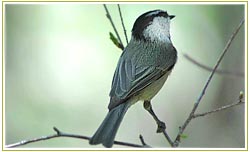About The Mountain Chickadee
 Most common in the Western coniferous forests, the Mountain Chickadee is known to be the only chickadee in North America with a white stripe on the eye area. This breed can be found in the southern part of California, the western areas of Texas, the inner British Columbia, the Rocky Mountain, and the Cascade-Sierra chains. The Mountain Chickadee’s length is between 5 to 6 inches. It has a short beak and a long tail. It also has a black bib and a black cap, as well as white cheeks. Its backside is typically pure gray, while the underside is a grayish white shade. Its wings and tail are a dark shade of gray. The male and female tend to be quite alike in this specie.
Most common in the Western coniferous forests, the Mountain Chickadee is known to be the only chickadee in North America with a white stripe on the eye area. This breed can be found in the southern part of California, the western areas of Texas, the inner British Columbia, the Rocky Mountain, and the Cascade-Sierra chains. The Mountain Chickadee’s length is between 5 to 6 inches. It has a short beak and a long tail. It also has a black bib and a black cap, as well as white cheeks. Its backside is typically pure gray, while the underside is a grayish white shade. Its wings and tail are a dark shade of gray. The male and female tend to be quite alike in this specie.
The Mountain Chickadee Nesting Preferences
This breed likes to build nests within holes of rotten or dead trees. Nests are often made out of rough materials, like moss, and covered with plant fibers or hair. Mountain Chickadees may make use of loosely bundled fur to cover new eggs while the female searches for food. The eggs, laid five to eight at a time, are white speckled with slight scarlet brown spots. A nesting area’s elevation can be between 1 to 23 feet from the soil. As the eggs hatch, the female Mountain Chickadee will take care of the young ones, until they may be left alone so that the mother can help the male gather food. After 21 days, the young ones may be expected to leave their mother’s nest, though they may stay within the territory for 14 to 21 days more before they go off and mark their own territories.
Building a Birdhouse For The Mountain Chickadee
A birdhouse for the Mountain Chickadee should have a floor measuring 4 inches x 4 inches, with vertical measurement of 8 to 10 inches from floor to ceiling. The main opening should be 1¼ inch in diameter placed about 7 inches above the floor. It must be set up at a height of 6 to 15 feet from the ground.
The Mountain Chickadee Mating Habits
The typically monogamous Mountain Chickadee will defend its territory forcefully as the breeding season progresses. During winter, however, it will enter flocks of mixed species, and will be likely to find a mate there.
The Mountain Chickadee Feeding Preferences
In the fall, the Mountain Chickadee will gather and store food that it will eat in the winter. Storage areas are under tree barks, within clusters of pine needles, and beneath the soil. It picks up insects from leaves, exposed twigs, and bark of trees, and may be seen hanging upside-down while they do so.
Interesting Mountain Chickadee Facts
 The Mountain Chickadee prefers to dwell in dry, coniferous woods, in trees like the ponderosa pine. These birds can also be seen in aspen forests in high altitudes in the warm season, while the winter may send them to dwell in juniper trees. During the latter part of summer, the younglings will have left their mothers’ nests and settle in a new territory, where they will most likely stay for the rest of their existence. Poecile gambeli is the scientific name of the Mountain Chickadee. It is classified under the order Passeriformers, family Paridae.
The Mountain Chickadee prefers to dwell in dry, coniferous woods, in trees like the ponderosa pine. These birds can also be seen in aspen forests in high altitudes in the warm season, while the winter may send them to dwell in juniper trees. During the latter part of summer, the younglings will have left their mothers’ nests and settle in a new territory, where they will most likely stay for the rest of their existence. Poecile gambeli is the scientific name of the Mountain Chickadee. It is classified under the order Passeriformers, family Paridae.